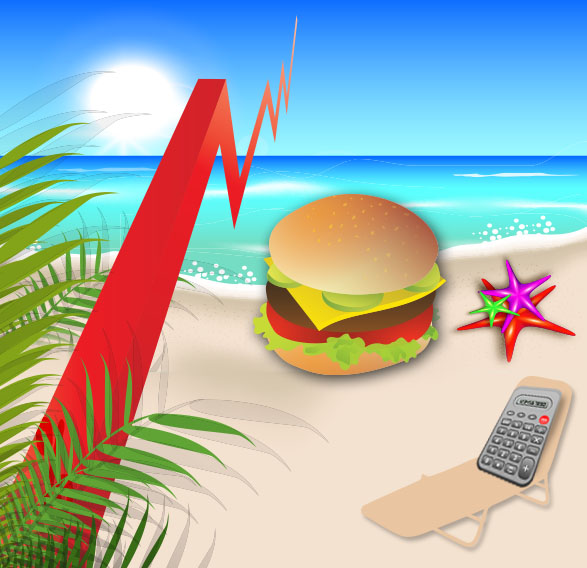I Want A Cheeseburger in Paradise, please?
In the Buffet that is life are you a Jimmy or a Warren?
By Robbie Burch & Andrea Schlack
Money is lost or found depending upon how credit lines are granted to customers, and PICB has been the Printer’s stalwart partner by providing services, tools, and ideas on how to improve their results. By focusing on The Printer’s Due Diligence process, and their company’s Collections Procedures, two of the three most important elements necessary to improving cash flow, any printer can put themselves in a position to be successful. ‘Due Diligence’ helps determine who should be allowed a ‘credit line’, and ‘Collections’ is necessary for when a customer fails to pay, but all too often, Printers’ will ask us ‘How much credit would you give them?’ and it is this third question that is the last component necessary to establishing a ‘profit-based’ credit granting policy…..Remember, the longer your customer holds your money the less it is worth!
So, how do you set your credit limits? Are you more like Jimmy Buffet, A Parrot Head, wishing and hoping the customer pays timely or like Warren Buffet who calculates decisions based upon research and facts?
Does your credit policy allow you to afford the Margarita along with the cheeseburger?
Setting a customer’s credit limit is best determined by understanding how much money your company can afford to lose while still maintaining its financial integrity, therefore a simple formula to follow is:
Sales volume (–) hard expenses (–) soft expenses (=) profits. A (%) of profits is then divided between ‘credit reserves’, ‘maintenance reserves’ and ‘growth reserves.
The actual reserve percentages you dedicate for each category should be determined by your business’s financial advisers as it must be based upon your own unique financial data, but the recommended percentage for any ‘reserve’ should NEVER be 100% as that would limit the potential growth that can be obtained through the other ‘reserves’.
 Once your ‘credit reserve’ amount is determined, this is when Warren’s ethic of due diligence will help determine how much of your credit reserve can be dedicated to any specific customer. Not all customers pose equal risks, therefore, they should not ALL get equal amounts of credit. The question then becomes, ‘How much of your money you are lending?” NOT ALL loans are paid back’, therefore riskier credit customers should get less than lower risk companies, and companies that pose a significant risk to YOUR reserve—are CASH ONLY!
Once your ‘credit reserve’ amount is determined, this is when Warren’s ethic of due diligence will help determine how much of your credit reserve can be dedicated to any specific customer. Not all customers pose equal risks, therefore, they should not ALL get equal amounts of credit. The question then becomes, ‘How much of your money you are lending?” NOT ALL loans are paid back’, therefore riskier credit customers should get less than lower risk companies, and companies that pose a significant risk to YOUR reserve—are CASH ONLY!
Remember Buffet’s rule of investment and use it as a guide when setting your customer’s credit limit—Safe investments may grow more profitable at a slower pace than riskier one, and while riskier investments may more often pay greater dividends, if you cannot afford the loss you should stick to what is safe and then as profits increase greater risks can be taken safely!
Characteristics of a High-Risk Business:
- Recently formed (operating for less than three years)
- Insufficient or expired licensing (city, state, & county as required)
- The company does not have a physical address
- Having no known assets
- Mobile number (rather than a published land line)
- Previous collection claims
- Court records regarding contract issues/non-payment of debt
- Tax Liens
- UCC filings dis-proportionate to the size of the company
- Credit references indicate slow-pay/past-due
- Non-responsive credit references
Characteristics of an Average Risk Business:
- The customer has been in business for 3 – 10 years
- Foreign ownership but well established
- The principal has operated companies in the past which are now dissolved
- Home based business
- Toll-Free phone number (rather than a published land line)
- Court records regarding former employee’s/labor issues
- Tax liens which are older than 10 years and have been paid
- UCC filings are proportionate to the size of the company
- Credit references indicate slightly late but overall good payment history
Characteristics of a Low-Risk Business:
- The customer has been in business for over 10 years
- Successful affiliated businesses
- Has known assets
- Published land line for the phone number
- No Court records
- No Tax Liens
- Limited UCC filings
- Credit references indicate a positive payment history extending the entire time the customer has been in operation
Setting the appropriate terms and lines of credit for future customers will never be an exact science, but by asking important questions, like Warren, instead of just being positive, like Jimmy, the risk can become calculated rather than just plain risky. We all want to kick back and eat a cheeseburger in paradise, but if you set your credit lines correctly, maybe you’ll be able to afford that margarita too!





